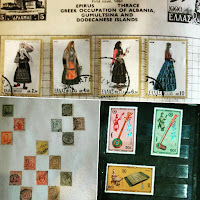Philately and the Past: SA Workshop reported by Shriya Gautam
 |
| An Album, a Stock book and the sheets from the Workshop |
If I have to talk about this workshop, it was probably one of the hardest we had to organise.
Stamps are almost impossible to link with archaeology but what's harder is getting them 'Workshop ready', especially since the Panel was borrowing from a private collection, which already had been exhibited.
The risk involved was too much! So, was the security I had already paid for it. (I was handling stamps worth a million dollars that afternoon and taking them amidst my bunch of loons to a place where coffee spills aren't uncommon, wasn't exactly risk free (we had some stamps right from the 1850s!)
So, amidst all the stress and the tension, the Philately Workshop finally happened on January 31, 2016.
The first job was to talk about what is a stamp, really? The Roland Hill idea behind paid postage, the history of this tiny scrap of paper which we were going to link with the past...
There were also questions to be answered. No one, not even historians, consider stamps as a source of history, which is a shame. So many things are as plain as the nose on one's face, if you look at a stamp carefully. Fewer still know the difference between philately and stamp collection.
So, it wasn't really news to me when the fact that even in the modern days, countries exhibit their culture via stamps, was surprising to some of the attendees.
Stamps are issued on every topic and so, while those from the past tell us a lot about colonial/mandate status of the now independent countries, the relatively new ones serve as a tool of cultural familiarisation.
As surgical gloves were donned and magnifying lenses popped out of the bags, the Volunteers spread across Barista Lavazza in Sector 17, Chandigarh, with coffee mugs in one hand and their observation sheets in another. The lighting, I have to admit, could have been more conducive but once these enthu-cutlets start, there's no stopping them!
Dress cultures of Greece and Spain were observed and photographed, Bhutanese Bridges, Mongolian musical instruments, the Khadi Textile and Colonial Stamps of the British Colonies were all under the purview of one magnifying glass or another.
And I? I felt like Mufasa surveying his pride as I walked among the tables, though I have to admit that given the lighting of the place and magnifying lenses, I did feel a bit like Professor Trelawney in her Divination Class.
The best bit: we were able to pay back the security amount and deliver the sheets back safely. Some of us even got to buy a few sets from our suppliers!



Comments
Post a Comment